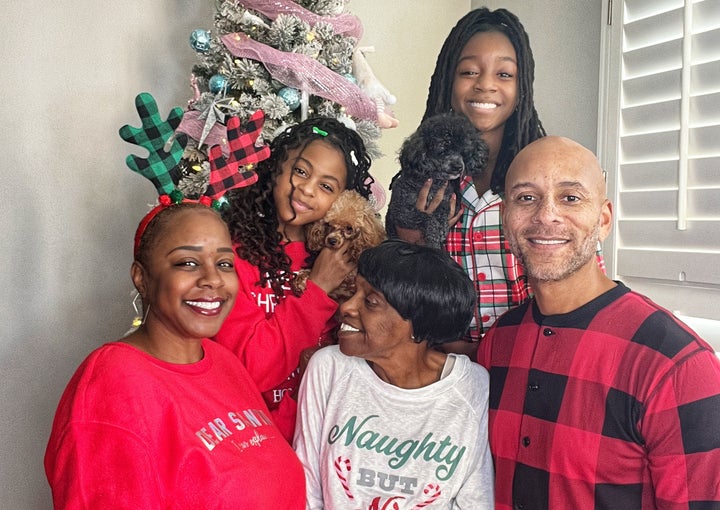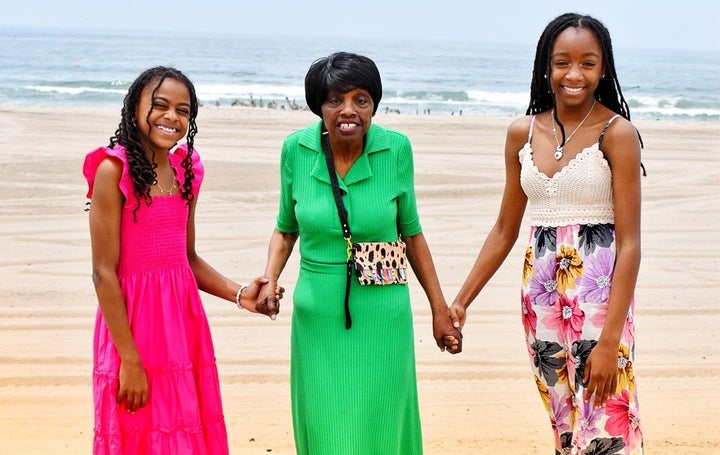When Ty Lewis’ mother, Gertrude Jordan, was diagnosed with Alzheimer’s disease in 2014, her daughters were 6 and a half and 4 years old. At the time, Lewis said, she explained their grandmother’s condition to them honestly and with compassion.
She told them: “Grandma is not the same like she used to be. She’s losing her memory and that means that she’s forgetting some things. And so what we’re going to do is we’re going to be loving, we’re going to just be gentle with her,” Lewis told HuffPost.
In 2021, Lewis’ father passed away, and her mother moved into her home so Lewis could be her primary caregiver. The girls, now 16 and 13, take an active role in caring for their grandmother.

When her mother was initially diagnosed, Lewis felt support was lacking for her family. She recalls sitting in the doctor’s office with Jordan. “[The doctor] handed me a pamphlet and said, ‘Your mother has dementia.’”
“I’ll never forget looking at my mom and seeing her cry, and I’ll never forget the empty feeling that I had on the inside, and just saying, ‘This can’t be the end,’” Lewis said.
Ten years later, it’s become possible to see that moment as the beginning of a new chapter for the family, one that has its challenges but also its joys. Lewis, who is based in Southern California, has created a community of almost 100,000 followers on her mother’s Instagram page. In sharing her story, she’s become an advocate for caregivers. She has also completed specialised training to become a certified Alzheimer’s and dementia care trainer and dementia practitioner.
Like Lewis, many dementia caregivers are also parents raising children, a situation sometimes called the “sandwich generation” that can be stressful and overwhelming for the person providing all the care. In one survey of 500 caregivers, 50% of sandwich generation caregivers who were caring for a loved one with Alzheimer’s disease or dementia said they felt like they were “drowning” and “unprepared for the role.”
An additional concern for caregivers who are parents is how to talk to their children about dementia and their older relative’s decline. The same survey found that 96% of caregivers found it challenging to discuss the diagnosis with their children, and 78% reported that it was “one of the hardest conversations they’ve had as a family.”
Here are some things to keep in mind when it comes to communicating with your children about a dementia diagnosis in the family.
Show by example.
Don’t worry too much about finding just the right words to explain what dementia is to your child.
“They learn by our doing,” said Lewis. Her daughters, she said, “watch the way that we’ve served her.”
“Because they saw us and what we do, they stepped in without hesitation,” Lewis said.
If your child has sat at the table and watched you spoon-feed your relative, then they’ve essentially received training for doing that task themselves.
Find ways for them to meaningfully contribute to their elder’s care.
Lewis said she doesn’t have the girls “do the heavy-duty stuff,” but one of her teens helps her mother get dressed, and both of them sometimes help her in getting to the bathroom.
Even younger children can use their skills to be of service. Lewis mentioned that her daughters spend time dancing and singing with their grandmother.
“My youngest is a singer, so she’s always singing to her because music therapy works,” Lewis said. “And my oldest is a dancer, and so she dances around the house with [her].”
Other ways that children can help care for an older relative might include feeding them, reading them books or playing games. For young children, going on walks, drawing pictures or even playing with sand or another sensory material can be good activities to do together.
Any activities your whole family engages in will give your children opportunities to interact with their relative.
Merle Griff, a family therapist in Florida who cared for her mother and later her husband when her own children were adults, told HuffPost that her oldest son “always tells the story” of taking her mother with them when he went to pick out an engagement ring. “I think they felt as though they still had a lot of experiences with her,” Griff said.
Because Griff’s mother had a stroke and was aphasiac and unable to use one side of her body, communication was “challenging.” Griff’s children had to adjust and learn to read her mother’s body’s signs, which she says included a lot of pointing with her good hand, as well as eye-rolling.
“They couldn’t be running around and talking to her at the same time,” Griff said. “They had to be sitting down, actually facing her, when they were communicating with her.”
Kids may also find that they need to literally slow down for a relative who is less mobile. Griff believes this process of having to adapt to a relative’s needs makes kids “stronger” and “more resilient,” in addition to more patient and kind.
Use media resources to start conversations with your child.
The pharmaceutical company Otsuka recently released a short animated video called “Where the Ocean Meets the Shore: Navigating Alzheimer’s Together.” It tells one grandmother’s story from the perspective of her grandchild. There are also a number of books ― different titles for different age groups ― that touch on the subject.
Resources like these can give parents an opening to talk with their children about what happening. Even when kids are small, they will know that things are changing around them. Lewis recommended “inviting them into the conversation... and inviting them into the caregiving process.”
Designate some time for your children — and yourself.
With appointments and paperwork adding to the load of caregiving at home, sandwich generation caregivers frequently find themselves short on the most valuable resource: time.
In the survey mentioned above, which was sponsored by Otsuka, 80% of parent caregivers said time with their kids suffers at least sometimes due to caregiving responsibilities. The number was even higher for employed parents (86%).
First, Griff recommended that you acknowledge you aren’t able to spend as much time with a child because of your caregiving. “Sometimes you have to say to children: ‘I understand that at times you may be upset or angry because I can’t spend this much time with you right now. But we’re a family and we have to stick together and sometimes one of us needs more time than the other ... Right now Grandma or Grandpa needs more of our time. So we need to stick together as a family and give them that time.’”
While you may not be able to spend as much time with your child, setting aside even a small amount of time to dedicate your attention to them can make a big difference. Try to do so with some kind of regularity.
And don’t forget to reserve a little bit of time to connect with your spouse or romantic partner. You will need respite from your caregiving duties on a regular basis, too.

Communicate openly, using developmentally appropriate language.
“I don’t hide anything at all,” Lewis said. “We’re very open. We’re very honest.” She noted that she lets her daughters know about the financial strain the family feels due to all the caregiving costs.
Griff recommended mentioning any big changes, such as a relative coming to stay, with some advance notice, so children can have time to adjust.
It’s also important for children to know what the disease is and what symptoms to expect. “They have to understand that the changes that they’re seeing in their grandparents are a result of that disease. That things may happen that didn’t happen before that are result of the disease,” Griff said. “For instance, sometimes people with Alzheimer’s disease or dementia can get angry. They go from being very patient people to sometimes getting very angry and losing their temper.” This shift in their relative’s personality can be hard for kids to comprehend.
One phrase that Lewis mentioned using with her daughters when their grandmother progresses to a new symptom is: “Grandma’s going into the next stage.”
Lewis also recommended Otsuka’s short film, with its metaphor of giving things back to the ocean, as a way to approach the subject of death.
“Having my mom here shows our children that life is a cycle,” Lewis said. “Our focus is on making my mom’s living situation the best that it can be while she’s here.”
Griff mentioned that when it comes to death, it’s the loss of a parent that is always at the top of kids’ minds. It’s important to reassure them that you yourself are healthy and will be here with them for a long time.
She also advised against describing death as “going to sleep,” since this can make children afraid of sleep.
Focus on the positive, and on what your family gains from caregiving.
It’s good to be transparent, but you also want to make sure that your kids aren’t only hearing you talk about the sacrifices that your caregiving situation has required. “Children are going to obviously pick up on that, and that’s the same attitude they’re going to have,” Griff said.
While it certainly involves a lot of sacrifice, children can understand your motivations to care for your relative, and can grasp the advantages of the situation.
Lewis said that she and her husband made the commitment to take in her mother because they wanted her to “age in place.” But having her in the home has positive effects for all members of the family.
“Keeping my mom at home not only benefits her, but also benefits us, because it humbles me as a daughter,” Lewis said.
For her own daughters, she said, “it’s teaching them to be loving. It’s teaching them to be kind.”
“While we are at home, serving my mom and taking care of her, it’s doing something on the inside of my girls,” Lewis said. “And as they become older, they’ll learn how to be great citizens, if you will, in society, and they’ll learn how to be more compassionate and loving and patient.”
